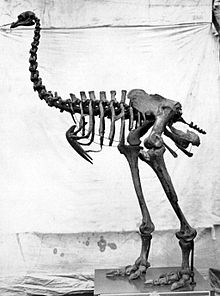| Heavy-footed moa Temporal range: Late Pleistocene-Holocene
| |
|---|---|

| |
| P. elephantopus skeleton photographed by Roger Fenton | |
| Scientific classification | |
| Domain: | Eukaryota |
| Kingdom: | Animalia |
| Phylum: | Chordata |
| Class: | Aves |
| Infraclass: | Palaeognathae |
| Order: | †Dinornithiformes |
| Family: | †Emeidae |
| Genus: | †Pachyornis |
| Species: | †P. elephantopus
|
| Binomial name | |
| †Pachyornis elephantopus | |
| Synonyms | |
|
List
| |
The heavy-footed moa (Pachyornis elephantopus) is a species of moa from the lesser moa family. The heavy-footed moa was widespread only in the South Island of New Zealand, and its habitat was the lowlands (shrublands, dunelands, grasslands, and forests).[3] The moa were ratites, flightless birds with a sternum without a keel. They also have a distinctive palate. The origin of these birds is becoming clearer as it is now believed that early ancestors of these birds were able to fly and flew to the southern areas in which they have been found.[3]
The heavy-footed moa was about 1.8 m (5.9 ft) tall, and weighed as much as 145 kg (320 lb).[4] Three complete or partially complete moa eggs in museum collections are considered eggs of the heavy-footed moa, all sourced from Otago. These have an average length of 226mm and a width of 158mm, making these the largest moa eggs[5] behind the single South Island giant moa egg specimen.[6]
- ^ Brands, S. (2008)
- ^ Checklist Committee Ornithological Society of New Zealand (2010). "Checklist-of-Birds of New Zealand, Norfolk and Macquarie Islands and the Ross Dependency Antarctica" (PDF). Te Papa Press. Retrieved 4 January 2016.
- ^ a b Davies, S. J. J. F. (2003)
- ^ Olliver, Narena (2005)
- ^ Tennyson, Alan J. D. (2006). Extinct birds of New Zealand. Paul Martinson. Wellington, N.Z.: Te Papa Press. p. 28. ISBN 978-0-909010-21-8. OCLC 80016906.
- ^ Gill, B. J. (2006). "A Catalogue of Moa Eggs (Aves: Dinornithiformes)". Records of the Auckland Museum. 43: 55–80. ISSN 1174-9202. JSTOR 42905885. Wikidata Q58623352.